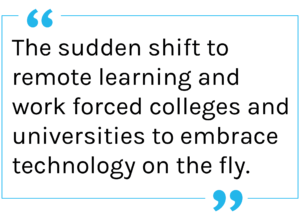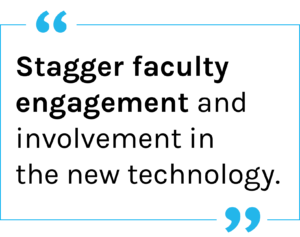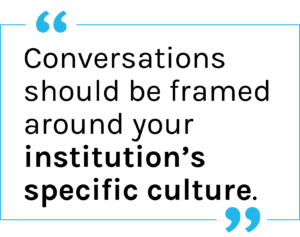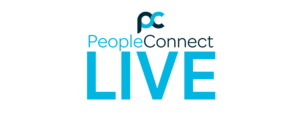How can institutions support their faculty through fast-paced digital transformation?
 Digitization is happening quickly at many HigherEd institutions, thanks to rapid advances in technology and the urgency presented by the COVID-19 pandemic. Some institutions, however, delay digitization or technology adoption because of actual or anticipated faculty resistance to technology. That’s where faculty change management comes in.
Digitization is happening quickly at many HigherEd institutions, thanks to rapid advances in technology and the urgency presented by the COVID-19 pandemic. Some institutions, however, delay digitization or technology adoption because of actual or anticipated faculty resistance to technology. That’s where faculty change management comes in.
According to a 2020 PeopleAdmin survey, 48% of institutions report having a predominantly paper process for faculty. Outdated paper processes mean more time spent on data entry, less data accuracy, and fewer analytic insights. There are countless reasons that digitization is the right move for administrative leaders as well as for faculty, but it’s important to make sure to offer the right support as your work towards a digital transformation. Read on to learn how to support your faculty through the digital transformation.
Accelerating Digitization
Before COVID-19, many colleges and universities were embracing technology, hosting online classes, and digitizing their workflows. Many others knew that digitization was on the horizon, but had plans that would take years to implement. The sudden shift to remote learning and work upended these plans and forced colleges and universities to embrace technology on the fly. This forced digital transformation is not necessarily a bad thing, but faculty who had to change the way they work overnight might have been left feeling unsupported and unprepared; now is the time to invest the resources in supporting your faculty in the new way of doing things.
necessarily a bad thing, but faculty who had to change the way they work overnight might have been left feeling unsupported and unprepared; now is the time to invest the resources in supporting your faculty in the new way of doing things.
Collaboration and Timeframe
The first step to offering the right resources to your faculty body as they continue to adapt to new methods of teaching, information keeping, and course tracking is to understand where they are coming from. Higher education institutions are generally slow to change, and the decision-making processes involve more people, more bureaucracy, and often, collaboration and partnership with other universities. Many faculty are bought into these slower decision-making processes, valuing long-form discussion and committee input over quickly implemented change.
To gain support from your faculty for digital transformation, it’s important to work closely with them through these processes. Your administrative teams can engage in focused conversation with faculty, offering the facts about the proposed technology or software. In the best forms of faculty change management, faculty are engaged in the decision; treat digital transformation as a partnership and a collaboration so they can feel ready to embrace change, rather than having it forced on them.
Training and Resources
Another important step for gaining faculty buy-in on digital transformation is to be sure to allocate the right amount of time and resources to training your faculty on any new software or technology they’re expected to use in the course of their work. As noted by Inside Higher Ed, “Faculty skepticism about online learning and other technological approaches to higher education is long-standing… too often campus administrators or technology advocates have… set instructors up for bad outcomes by imposing solutions on them without seeking their input or giving them adequate training.” Institutions should not expect faculty to jump seamlessly into new digital workflows or adapt to new teaching technologies without giving them the resources and time to learn the platforms. This takes time, but can be worth the delay if it means faculty are on board with the digital transformation plan.
 One suggestion about faculty change management best practices comes from Molly McDermott, a senior project manager and change management practitioner at Illinois Institute of Technology: stagger faculty engagement and involvement in the new technology. If your team can target a few early adopters who can work with a new digital platform, get comfortable with the software, and figure out how it supports their day-to-day work, those early adopters can then talk about their experience with their peers and support will spread naturally. Learn more from Molly in her on-demand conversation with PeopleAdmin’s Sarah Renneker at PeopleConnect Live.
One suggestion about faculty change management best practices comes from Molly McDermott, a senior project manager and change management practitioner at Illinois Institute of Technology: stagger faculty engagement and involvement in the new technology. If your team can target a few early adopters who can work with a new digital platform, get comfortable with the software, and figure out how it supports their day-to-day work, those early adopters can then talk about their experience with their peers and support will spread naturally. Learn more from Molly in her on-demand conversation with PeopleAdmin’s Sarah Renneker at PeopleConnect Live.
Faculty-Specific Conversations
When working to help faculty adopt a new digital platform, it’s also important to frame the conversation around what is important to them. How will this technology make their lives better and easier? Sometimes, the learning curve associated with technology leaves new users with the impression that they will have to do more work than before. You can reassure your faculty that the new processes are designed to save them time; focus on the small details that might resonate. For instance, a faculty information system like PeopleAdmin’s keeps data current so that creating custom bio sketches is as simple as selecting what should be included and downloading a formatted and editable form at the click of a button.
Offering concrete examples of tasks that faculty perform frequently (and might be frustrated by) can be an effective way to help them see the benefits of the change. Molly McDermott of Illinois Tech also suggests calling out how technology could simplify or ease processes and workflows that are unique to a specific department or college, demonstrating that these changes have been thought through and are truly designed to help that specific group.
benefits of the change. Molly McDermott of Illinois Tech also suggests calling out how technology could simplify or ease processes and workflows that are unique to a specific department or college, demonstrating that these changes have been thought through and are truly designed to help that specific group.
When discussing the benefits of online learning technologies specifically, it’s important to talk about the quality of instruction offered and the way it can augment traditional teaching, rather than simply focusing on the mechanics of time saved or efficiency. Faculty often put a higher priority on doing their jobs well than on saving time, so make sure you’re speaking their language: this tool will help you do your job better, not just faster.
Feedback Loops
 Of course, these conversations should all be framed around your institution’s specific culture. Educause writes, “The best way to know what faculty need is to ask them.” Engage with your faculty early in the process. Start an advisory committee, hold focus groups, or perform surveys; find out exactly what your faculty want or need from the digitization process, and learn what might be holding them back. Once your institution has engaged in the digital transformation or is implementing a new technology, be sure to set up feedback loops so that you know how the process is going and can tackle any small hiccups before they become bigger problems.
Of course, these conversations should all be framed around your institution’s specific culture. Educause writes, “The best way to know what faculty need is to ask them.” Engage with your faculty early in the process. Start an advisory committee, hold focus groups, or perform surveys; find out exactly what your faculty want or need from the digitization process, and learn what might be holding them back. Once your institution has engaged in the digital transformation or is implementing a new technology, be sure to set up feedback loops so that you know how the process is going and can tackle any small hiccups before they become bigger problems.
Final Thoughts: Faculty Change Management is Key
As your institution goes through changes and challenges, you want to be sure everyone is on the same page—including your faculty. It might seem like a tough hurdle, but you can get your faculty on board with the digital transformation your institution needs. Be sure to dive into the faculty mindset, ask for feedback and input, have focused conversations, offer plenty of training time and resources, and highlight the benefits of new technology. With these strategies, you can have buy-in on digitization from every corner of your campus.
For more information, please watch our on-demand session about digital transformation from PeopleConnect Live!
